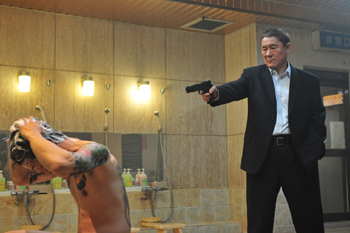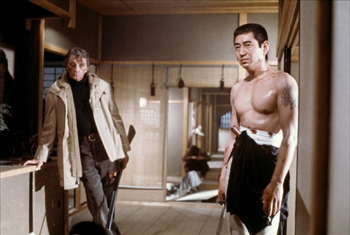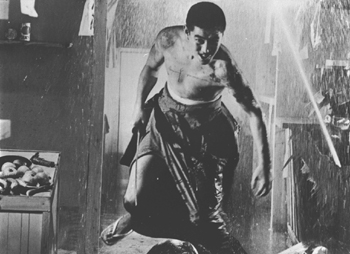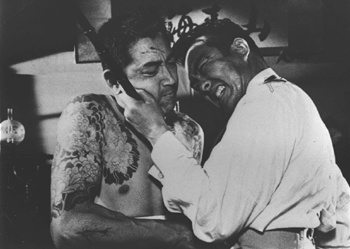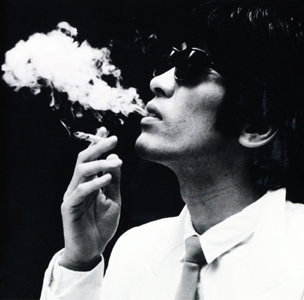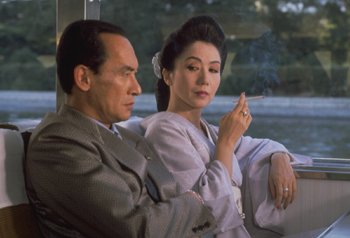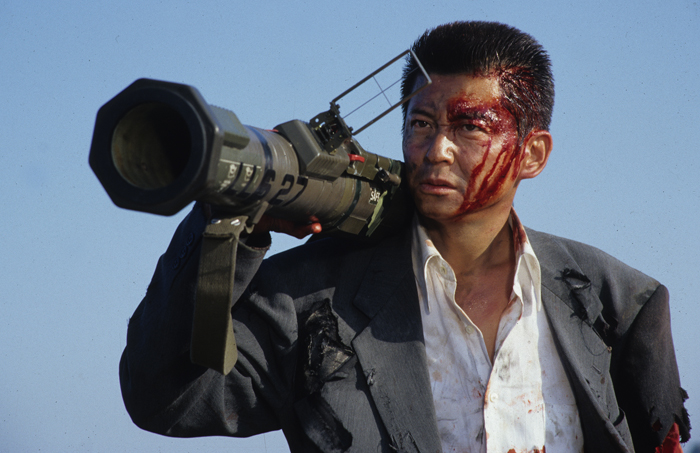 Sho Aikawa in director Takashi Miike`s DEAD OR ALIVE. Photo courtesy of Japan Society. © 1999 Kadokawa Shoten Co., Ltd.
Sho Aikawa in director Takashi Miike`s DEAD OR ALIVE. Photo courtesy of Japan Society. © 1999 Kadokawa Shoten Co., Ltd.Japanese Gangster Film Series Spans 50 Years, with 15 films and a Guest Appearance by an American Movie Legend Source: Japan Society Special Thanks to Shannon Jowett and Joshua Pagillo
Hardest Men in Town: Yakuza Chronicles of Sin, Sex & Violence March 9-19, 2011, at Japan Society New York, NY: Years before Coppola’s GODFATHER enthralled a nation and decades before SOPRANOS and BOARDWALK EMPIRE fed viewers’ insatiable appetites for serial gangster melodrama, the yakuza (Japanese mafia) were mainstays of the Japanese film industry. From March 9-19, Japan Society presents the Globus Film Series "Hardest Men in Town: Yakuza Chronicles of Sin, Sex & Violence", featuring 15 seminal films encompassing 50 years of snarling, swaggering, tattooed and inexplicably sexy cinema icons from Japan. In addition to celebrated classics by Hideo Gosha (THE WOLVES), Kinji Fukasaku (COPS VS. THUGS, BATTLES WITHOUT HONOR AND HUMANITY), the series includes lesser known titles and overlooked gems by Seijun Suzuki (YOUTH OF THE BEAST), Takashi Miike (DEAD OR ALIVE), Rokuro Mochizuki (A YAKUZA IN LOVE, ONIBI: THE FIRE WITHIN) and Sydney Pollack (THE YAKUZA), as well as contemporary incarnations of the genre such as Takeshi Kitano’s OUTRAGE.
Among 8 premieres are 4 films never-before seen outside of Japan: Teruo Ishii’s THE WALLS OF ABASHIRI PRISON (pt. 3): LONGING FOR HOME, Kiyoshi Saeki’s BRUTAL TALES OF CHIVALRY, Rokuro Mochizuki’s A YAKUZA IN LOVE, Toru Kawashima’s RYUJI; the U.S. Premieres of Mochizuki’s ONIBI: THE FIRE WITHIN, Tadashi Sawashima’s THEATER OF LIFE: HISHAKAKU, Hideo Gosha’s YAKUZA WIVES; and the New York Premiere of OUTRAGE. Kicking off the festival, filmmaker Paul Schrader (dir.: BLUE COLLAR, AMERICAN GIGOLO; writer: TAXI DRIVER, LAST TEMPTATION OF CHRIST) appears March 9 to introduce THE YAKUZA, which he penned, and take part in a Q&A following the screening. In conjunction with the March 10 screening of ONIBI: THE FIRE WITHIN, Japan Society welcomes renowned author Jake Adelstein (Tokyo Vice), one of the foremost experts on organized crime in Japan, for the discussion "Yakuza in Popular Media & Real Life: Cracks & Chasms". The March 11 screening of THE WOLVES is followed by the opening week “Gangsta Party”, with prizes for the best modern day gangster garb or any man or woman wearing the classic yakuza kimono.
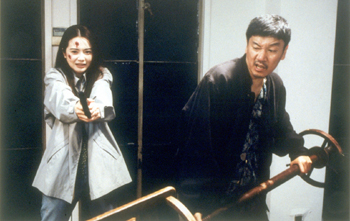 Yuna Natsuo and Eiji Okuda in A YAKUZA IN LOVE. Photo courtesy of Japan Society. © 1997 Toei Co., Ltd
Yuna Natsuo and Eiji Okuda in A YAKUZA IN LOVE. Photo courtesy of Japan Society. © 1997 Toei Co., LtdSteeped in cryptic ritual and customs, from full-body tattoos to missing digits, the violent, romantic world of yakuza has excited the imagination and inspired Japanese cinema since the 60s. In the darkness of movie theaters, the yakuza became the very picture of superhuman macho cool and reptilian menace. Showing grand visions of manly amity and betrayal, early productions featured chivalrous kimono-clad, sword-wielding gangsters and gamblers, who set the stage for today`s ruthless gun-toting villains dealing in debt, hustling hardcore porn and scheming and scamming in dark trades and even darker deeds. “The genre’s cultural phenomenon harkens back to the days of when samurai still embodied traditionalist values of honor, selfless duty (giri) and the noble warrior spirit (ninkyo) on the silver screen,” notes Samuel Jamier, who oversees Japan Society’s film programming and curated the series. “The yakuza--shadowy demimonde of organized crime (which included wandering gamblers and lowly peddlers)--rivaled with the noble swordsmen as the representatives of honor and heroism, in the context of a rapidly changing society trying to come to terms with a shameful defeat.” "Hardest Men in Town: Yakuza Chronicles of Sin, Sex & Violence" takes place March 9-19. Japan Society is located at 333 East 47th Street between First and Second avenues (accessible by the 4/5/6 at 42nd Street-Grand Central Station or the E and V at Lexington Avenue and 53rd St.) Tickets are $12/$9 members, students & seniors, EXCEPT: March 10 is $12/$8 for lecture only, $12/$9 for film only, or $16/$12 for lecture and film; and the March 11 The Wolves screening is $16/$12 including after party. For reservations visit www.japansociety.org or call the box office at 212-715-1258. Purchasers of more than 5 tickets for at least 5 different films receive $2 off of each ticket (available only in person at the box office or by telephone— special offer not available for online purchases.)
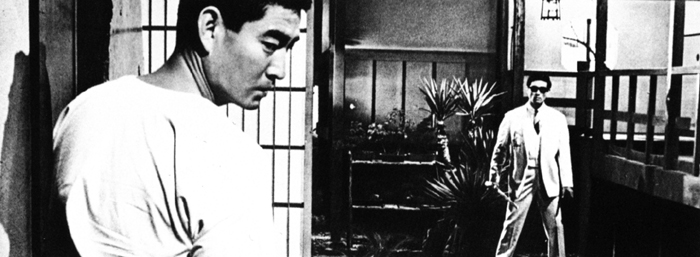 Ken Takakura and Naoki Sugiura in THE WALLS OF ABASHIRI PRISON: LONGING FOR HOME. Photo courtesy of Japan Society. © 1965 Toei Co., Ltd.
Ken Takakura and Naoki Sugiura in THE WALLS OF ABASHIRI PRISON: LONGING FOR HOME. Photo courtesy of Japan Society. © 1965 Toei Co., Ltd.FILM DETAILS AND SCREENING SCHEDULE
THE YAKUZA Wednesday, March 9 at 7:30 pm **Introduced by writer/director Paul Schrader, followed by a Q&A. 1975, 112 min., color, in English and Japanese (with English subtitles). Directed by Sydney Pollack. With Robert Mitchum, Ken Takakura, Brian Keith, Herb Edelman, Richard Jordan, Keiko Kishi, Eiji Okada, James Shigeta, Kyosuke Machida, Christina Kokubo, Eiji Go, Lee Chirillo. Few films show more deference and respect to Japanese film culture than Academy Award-winning director Sydney Pollack`s overlooked 1970s gem, THE YAKUZA. Both a taut thriller and a touching, finely layered character piece, the film features Robert Mitchum in one of his finest roles and shows Pollack in absolute command of his craft. Between making THE WAY WE WERE and THREE DAYS OF THE CONDOR, Pollack directed this little-seen homage to yakuza cinema from a script by Paul Schrader (TAXI DRIVER, RAGING BULL) and Robert Towne (CHINATOWN). Mitchum stars as Harry Kilmer, a former soldier who returns to Japan to help rescue the daughter of his friend George Tanner (Brian Keith). Once he arrives, Kilmer discovers that the daughter has been kidnapped by the yakuza. To save the girl, Kilmer finds himself with no other options than to enlist the help of an old and dangerous acquaintance, Tanaka (Ken Takakura). Behind the twists and double-crosses, there emerges the elegiac celebration of the chivalric male relationships of countless American Westerns, and quite possibly the most original introduction to the yakuza movie genre. ONIBI: THE FIRE WITHIN (??, Onibi) Thursday, March 10 at 8:15 pm **U.S. Premiere **Introduced by author Jake Adelstein (Tokyo Vice) 1997, 101 min., 35 mm, color, in Japanese with live English subtitles. Directed by Rokuro Mochizuki. With Yoshio Harada, Reiko Kataoka, Sho Aikawa, Ko Kitamura. Often regarded as director Rokuro Mochizuki`s masterpiece, ONIBI injects both sexual passion and subdued sentiment into the macho world of yakuza cinema. Within the confines of the genre, Mochizuki artfully builds a parable of implacable fate, probing the leading performer`s inner life with a calm intensity that is almost unparalleled. Noriyuki Kunihiro (Yoshio Harada, in one of his most unforgettable roles) is a yakuza who has just spent half a lifetime in prison for a double murder. Although his former acolytes try to tempt him back into the fold, he prefers to put his aging but still strong body to more honest work. He finds love in the person of a young pianist and trouble soon follows. Coming from a director who started his career in adult film, this is a surprisingly spare and emotionally savage film. ** Related Lecture - "Yakuza in Popular Media & Real Life: Cracks & Chasms" Thursday, March 10 at 6:30 pm From popular films to games and comic books, yakuza culture has been portrayed and discussed across the media spectrum with a wide degree of accuracy. Jake Adelstein, author of Tokyo Vice--one of the rare books revealing real yakuza culture in Japan— discusses the differences between the images the yakuza want to project and how the major groups really function, and the taboos of depicting yakuza in Japan.
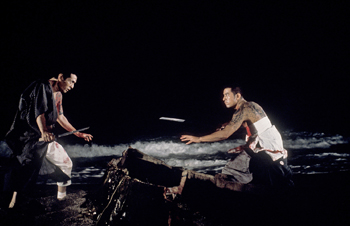 Tatsuya Nakadai and Isao Natsuyagi in THE WOLVES. Photo courtesy of Japan Society. © 1971 Toho Co., Ltd.
Tatsuya Nakadai and Isao Natsuyagi in THE WOLVES. Photo courtesy of Japan Society. © 1971 Toho Co., Ltd.THE WOLVES (????, Shussho Iwai) Friday, March 11 at 7:30 pm 1971, 131 min., 35 mm, color, in Japanese with English subtitles. Directed by Hideo Gosha. With Tatsuya Nakadai, Noboru Ando, Kyoko Enami, Tetsuro Tanba. Directed by award-winning filmmaker Hideo Gosha (SWORD OF THE BEAST) and scored by Kurosawa`s legendary composer, Masaru Sato (YOJIMBO, THRONE OF BLOOD), THE WOLVES features Tatsuya Nakadai (HARAKIRI, RAN, KAGEMUSHA), who leads an all-star cast (alongside real-life yakuza-turned-actor Noboru Ando). In 1929, to celebrate the Showa Emperor Hirohito`s ascension to the throne, hundreds of yakuza were pardoned and released from jail, for better or worse. Upon his release, Seiji Iwahashi realizes the world is disintegrating from moral rot and finds himself at the tattered edge of what he takes to be civilization and the shattered remains of a once honorable underworld. The essential thrust of the tale-- uprooted men, strangers in a strange world—cuts as acute and sharp as samurai sword, while the mood of resigned bitterness wafts through the film like incense. ** Filmgoers are invited to the “Gangsta Party” afterparty with all-female Japanese punk rock band High Teen Boogie. Costume suggestions: old-school gangsta, modern-day playa or a high rolla. Free entry for ladies and gentlemen who come in a kimono (limited to availability.)
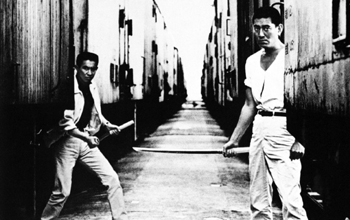 THE WALLS OF ABASHIRI PRISON: LONGING FOR HOME. Photo courtesy of Japan Society. © 1965 Toei Co., Ltd.
THE WALLS OF ABASHIRI PRISON: LONGING FOR HOME. Photo courtesy of Japan Society. © 1965 Toei Co., Ltd.THE WALLS OF ABASHIRI PRISON (pt. 3): LONGING FOR HOME (????? ???, Abashiri Bangaichi: Bokyo-hen) Saturday, March 12 at 1 pm **International Premiere 1965, 89 min., 35 mm, color, in Japanese with live English subtitles. Directed by Teruo Ishii. With Ken Takakura, Hiroko Sakuramachi, Naoki Sugiura, Kunie Tanaka. Forty-six years after its Japanese release, what many consider the most outstanding episode of the ABASHIRI series stands firmly on its own, and, presented for the first time outside of Japan, is bound to satisfy even the uninitiated. Upon returning to his hometown of Nagasaki, recently released prisoner Shinichi Tachibana (Ken Takakura) wants to become a better man but must go back to his old gangster ways and former clan, the Asahi, in order to pay back a past debt. Trouble brews when the rival gang that was responsible for sending him to prison learns of his return. Left with no alternative, Tachibana decides to take them on.
BRUTAL TALES OF CHIVALRY (?????, Showa Zankyo den) Saturday, March 12 at 3 pm **International Premiere 1965, 90 min., 35 mm, color, in Japanese with live English subtitles. Directed by Kiyoshi Saeki. With Ken Takakura, Ryo Ikebe, Yoshiko Mita, Shinjiro Ebara. With BRUTAL TALES OF CHIVALRY, the honorable yakuza formula loiters on the threshold of formal perfection. Returning imperial soldier Gennosuke (Ken Takakura) finds his hometown hardly more than a pile of rubble— reduced to a dead zone of rusted, unpopulated townscapes. With the sheer power of his will and moral rectitude, Gennosuke must rebuild the local marketplace and protect it from the unscrupulous hands of a rival gang that couldn`t care less about chivalry and honor.
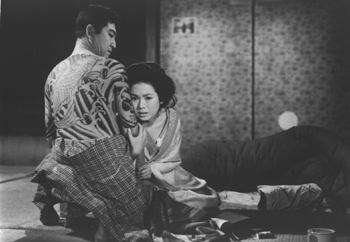 Ryoji Tsurumi and Yoshiko Sakuma in THEATER OF LIFE: HISHAKAKU. Photo courtesy of Japan Society. © 1963 Toei Co. Ltd.
Ryoji Tsurumi and Yoshiko Sakuma in THEATER OF LIFE: HISHAKAKU. Photo courtesy of Japan Society. © 1963 Toei Co. Ltd.THEATER OF LIFE: HISHAKAKU (???? ???, Jinsei Gekijo: Hishakaku) Saturday, March 12 at 5:15 pm **U.S. Premiere 1963, 95 min., 35 mm, color, in Japanese with live English subtitles. Directed by Tadashi Sawashima. With Koji Tsuruta, Ken Takakura, Yoshiko Sakuma and Ryunosuke Tsukigata. Tadashi Sawashima`s THEATER OF LIFE launched the 1960s ninkyo eiga boom and is in many ways genre`s blueprint. As honorable a gangster as is humanly possible, Hishakaku (Koji Tsuruta) loves Otoyo, a courtesan, but his obligations to the yakuza code keep them apart, not the least because of his stint in prison. During this time, Otoyo struggles against sinister gangsters who see her not as the sweetheart of a chivalrous gambler doing time for his gang, but as a simple commodity. The film made both Toei studio actors Koji Tsuruta and Ken Takakura superstars of the yakuza genre, though the fragile beauty of actress Yoshiko Sakuma impresses the most.
BLOOD OF REVENGE (???????????, Meiji kyokyakuden: Sandaime shumei) Saturday, March 12 at 7:30 pm 1965, 91 min., 16 mm., color, in Japanese with English subtitles. Directed by Tai Kato. With Koji Tsuruta, Junko Fuji, Kanjuro Arashi, Masahiko Tsugawa. The outstanding performance by Koji Tsuruta, the yakuza genre`s first star, is the most commanding reason to see this film, next to über-stylist director Tai Kato`s masterly and distinctive mise en scène. In 1907 Osaka, Asajiro (Tsuruta) lives between a rock and a hard place: he has to keep his business clean and running, tame his late oyabun`s hot-blooded son and suffer the throes of his impossible love for beautiful geisha Hatsue (Junko Fuji). Life is tough, but misdeeds do not remain unavenged as trickling blood swells to a flood.
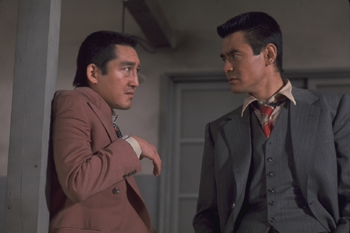 Hiroki Matsukata and Bunta Sugawara in COPS VS. THUGS. Photo courtesy of Japan Society. © 1975 Toei Co., Ltd.
Hiroki Matsukata and Bunta Sugawara in COPS VS. THUGS. Photo courtesy of Japan Society. © 1975 Toei Co., Ltd.COPS VS. THUGS (???????, Kenkei tai soshiki boryoku) Sunday, March 13 at 3:15 pm 1975, 100 min., 35 mm, color, in Japanese with English subtitles. Directed by Kinji Fukasaku. With Bunta Sugawara, Seizo Fukumoto, Reiko Ike, Nobuo Kaneko, Yoko Koizumi. With all the grunting doggedness of the real life crime, director Kinji Fukasaku puts the spotlight on the forces of grand corruption and the ferocious business of butting heads with the law. It’s 1963 and the Kurashima City police have spent the seven years eradicating the mayhem-making yakuza gangs. The last two remaining gangs, Ohara and Kawade, are in tatters, with the Ohara boss in prison. But with the police force full of corrupt officers, the gangs begin to prosper once again. Soon it`s not only Cops vs. Thugs, but Thugs vs. Thugs and Cops vs. Cops, with genre supremo Bunta Sugawara as a police detective who makes Dirty Harry look like a rent-a-cop.
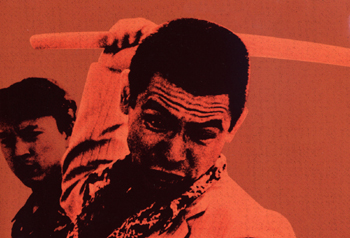 Bunta Sugawara in BATTLES WITHOUT HONOR AND HUMANITY: PROXY WAR. Photo courtesy of Japan Society. © 1973 Toei Co., Ltd.
Bunta Sugawara in BATTLES WITHOUT HONOR AND HUMANITY: PROXY WAR. Photo courtesy of Japan Society. © 1973 Toei Co., Ltd.BATTLES WITHOUT HONOR AND HUMANITY A.K.A. THE YAKUZA PAPERS (pt. 3): PROXY WAR (???????????, Jingi naki tatakai: Dairi senso) Sunday, March 13 at 5:30 pm 1973, 91 min., 35 mm, color, in Japanese with English subtitles. Directed by Kinji Fukasaku. With Bunta Sugawara, Akira Kobayashi, Tsunehiko Watase, Shingo Yamashiro, Reiko Ike, Nobuo Kaneko, Hiroki Matsukata, Tetsuro Tamba. This film is the centerpiece of the classic, five-film, postwar yakuza arch-epic— almost impossibly alert to the constant transactions of power within the unrepentantly violent world of Hiroshima gangsters. Inspired by real-life events, BATTLES breathlessly accumulates unabashed close-ups of bloodletting and wounded bodies flying left and right, front and back. This third installment has the most treacherous plot of the lot— plotting, counter-plottings, and dizzying alliances and betrayals with only one certainty: violence. By fair means mostly foul, we are led into battle and bloody murders, with jitsuroku ("docudrama"-style) star Bunta Sugawara at the center of it.
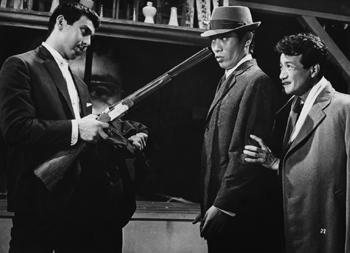 Jo Shishido, Akiji Kobayashi, and Tamio Kawaji in YOUTH OF THE BEAST. Photo courtesy of Japan Society. © 1963 Nikkatsu Corporation.
Jo Shishido, Akiji Kobayashi, and Tamio Kawaji in YOUTH OF THE BEAST. Photo courtesy of Japan Society. © 1963 Nikkatsu Corporation.YOUTH OF THE BEAST (?????, Yaju no seishun) Sunday, March 13 at 7:30 pm 1963. 92 min., 35 mm, color, in Japanese with live English subtitles. Directed by Seijun Suzuki. With Joe Shishido, Misako Watanabe, Tamio Kawaji, Ichiro Kijima, Mizuho Suzuki Seijun Suzuki`s breakthrough film is faster, rougher and wilder than most of his other outings (except perhaps the outrageously off-the-wall BRANDED TO KILL). Raw, rugged and tumbling out of nowhere, Jo (Joe Shishido, a frequent leading man in Suzuki`s films) wants employment and wants it now. He barges into the headquarters of a notorious yakuza organization and there he proceeds to beat the living daylights out of the goons, points a gun at the boss and politely asks for a job. The boss is impressed and puts him on the payroll. Jo then heads over to the rival faction`s gang and repeats, inciting an all-out gang war. This early Suzuki masterpiece is a precursor to the late 1990s visual extravaganza of Takashi Miike and others.
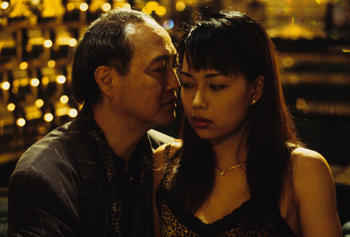 Renji Ishibashi and Mizuho Koga in DEAD OR ALIVE. Photo courtesy of Japan Society. © 1999 Kadokawa Shoten Co., Ltd.
Renji Ishibashi and Mizuho Koga in DEAD OR ALIVE. Photo courtesy of Japan Society. © 1999 Kadokawa Shoten Co., Ltd.DEAD OR ALIVE (???, Hanzaisha) Tuesday, March 15 at 7:30 pm 1999, 105 min., 35 mm, color, in Japanese and Mandarin with English subtitles. Directed by Takashi Miike. With Riki Takeuchi, Sho Aikawa, Renji Ishibashi, Hitoshi Ozawa, Shingo Tsurumi, Kaoru Sugita, Ren Osugi. A mind-boggling carnival of ultra-violence, massive drug use, punch-drunk camerawork and unending stroboscopic editing, perfectly calculated to induce an outbreak of rapture that will leave the viewer shaking and ringing from the shock. Miike`s legendary DEAD OR ALIVE pits a yakuza of Chinese descent (Riki Takeuchi) against a Japanese cop (Sho Aikawa) in the mean streets of Tokyo`s crime-infested Shinjuku area, prowled by warring factions that vie for supremacy. Their fated encounter, propelled by an astonishing opening reel of hyperspeed action, leads a truly out-this-earth, apocalyptic conclusion, perhaps the most spectacular showdown ever committed to celluloid. Visuals, courtesy of HANA-BI D.P. Hideo Yamamoto, are slick and arresting and give a proud, bloody-minded majesty to the trip.
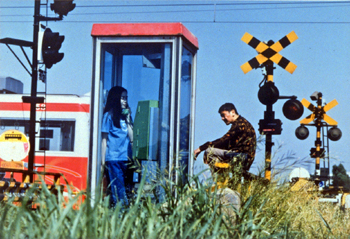 Yuna Natsuo and Eiji Okuda in A YAKUZA IN LOVE. Photo courtesy of Japan Society. © 1997 Toei Co., Ltd.
Yuna Natsuo and Eiji Okuda in A YAKUZA IN LOVE. Photo courtesy of Japan Society. © 1997 Toei Co., Ltd.A YAKUZA IN LOVE A.K.A. VILLAINOUS LOVE (???, Koi Gokudo) Thursday, March 17 at 7:30 pm **International Premiere! 1997, 110 min., 35 mm, color, in Japanese with English subtitles. Directed by Rokuro Mochizuki. With Eiji Okuda, Yuna Natsuo, Shunsuke Matsuoka. A dark, delicate, comic and complicated telling of a hard-as-nails, simple love story. Boy meets girl; boy falls in love, boy drugs girl; boy and girl start a rather twisted, chemical-fueled affair; things get sour. The boy is a low-ranking ne`er-do-well yakuza in an ill-fated gang, and the girls is a waitress who should probably know better. Auteur Rokuro Mochizuki (ONIBI: THE FIRE WITHIN; ANOTHER LONELY HITMAN), director and co-writer, has fashioned this unlikely romance between two mismatched lost souls into a black comedy of startling directness and intensity, following the old boy`s fumbling (and often funny) attempts at romance through questionable methods of courtship (which include kidnapping). Generously spiced graphic sex scenes alternate with moments of lyricism and otherworldly calm, subtly layering the characters and their path to ruin. As the strange relationship blossoms, the yakuza`s drug addiction and unstoppable habits of destruction threaten to destroy everything. ** From 6:00-7:30 pm, ticketholders get an exclusive sneak preview of Japan Society’s spring exhibition "Bye Bye Kitty!!! Between Heaven and Hell in Contemporary Japanese Art", opening March 18. Among 40 installations of sculpture, painting, video and photography, from some of the most evocative artists living and working in Japan today, are such genre-appropriate works as a dress with yards of blood streaming from it, a bevy of geisha grandmothers, happy-go-lucky school girls committing harakiri, a life-size glass-bulb-bedazzled taxidermy deer, a tattooed warrior, and a spectacular 23-foot mural of mountains composed of thousands of dead salarymen.
RYUJI (??) Friday, March 18 at 7:30 pm **International Premiere! 1983, 92 min., 35 mm, color, in Japanese with live English subtitles. Directed by Toru Kawashima. With Shoji Kaneko, Eiko Nagashima, Koji Kita, Kinzoh Sakura. A fragile film, not unlike the performance of the lead actor/writer Shoji Kaneko, who succumbed to cancer one week after the film`s release. RYUJI is a portrait of a young yakuza who wants to leave the underworld, for the sake and love of his wife and daughter, after a long stint in jail. This anti-noir film pulses with unusual sheen and clarity, touched with breathtaking moments of loveliness and hints of peace, the blend of moral brinksmanship, and restrained visuals. The pleasures of the film reside in the mischievous yet tolerant recognition that behind brutality lies human frailty, in its infinite range. The manner of its delivery is so disarmingly graceful— lacking neither emotional impact nor aesthetic punch— that you can almost feel the blood of the film flow. With realism reminiscent of the Actors Studio`s famed method (Kaneko joined a real gang to capture the essence of the role and the world in which the yakuza live), the drama comes to life with the support of a formidable cast (notably Kaneko’s real-life daughter).
YAKUZA WIVES (??????, Gokudo no onna-tachi) Saturday, March 19 at 5 pm **U.S. Premiere 1986, 120 min., 35 mm, color, in Japanese with live English subtitles. Directed by Hideo Gosha. With Shima Iwashita, Rino Katase, Akiko Kana, Riki Takeuchi. What if the hardest man in town was a woman? While her husband is in prison doing time, Tamaki (Shima Iwashita), the wife of a yakuza capo, is not wasting her time— she runs her spouse`s gang like Margaret Thatcher ruled the U.K.: with an iron fist. Meanwhile, Makoto (Rina Katase), her voluptuous younger sister, marries a member of a rival band after being raped by him. The two women decide the mortality of the men in their lives is about to go north. Following reportage by journalist Shoko Ieda, who spent a year living among 28 wives of gangsters, YAKUZA WIVES became a huge hit and the first movie of a long-running classic series exposing the women who live in the shadows in a harsh, bright, crimson light.
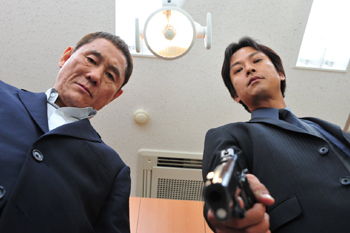 Takeshi Kitano and Kippei Shiina in OUTRAGE. Photo courtesy of Japan Society. © 2010 “Outrage” Production Committee
Takeshi Kitano and Kippei Shiina in OUTRAGE. Photo courtesy of Japan Society. © 2010 “Outrage” Production CommitteeOUTRAGE: THE WAY OF THE MODERN YAKUZA (??????, Autoreiji) Saturday, March 19, at 7:30 pm **New York Premiere 2010, 109 min., 35 mm, color, in Japanese with English subtitles. Directed by Takeshi Kitano, With Beat Takeshi, Kippei Shiina, Ryo Kase, Tomokazu Miura, Jun Kunimura. "Beat" Takeshi Kitano returns to a world without heroes, “as violent, amoral and misanthropic as a Jacobean play” (Maggie Lee, The Hollywood Reporter). OUTRAGE is director Takeshi Kitano`s first yakuza film after BROTHER (2000) and arguably his best film in a decade, raging with the raw power of his early works (A VIOLENT COP, SONATINE), though with a less minimalistic style. His representation of internecine gang rivalry and imploding power structure stands up to Kinji Fukasaku`s seminal BATTLES WITHOUT HONOR series in complexity and unsentimental attitude, with humor as mean and dry as a straight-up martini. The filming of violence, too, is exemplary, and enough to shame more frenzied filmmakers, with the camera largely keeping its distance rather than joining in with the bloodshed.
Special Guests
Paul Schrader is the director of 17 films and one of the most celebrated screenwriters in the industry. Influenced by visionaries such as Yasujiro Ozu, Robert Bresson, and Carl Theodor Dreyer, Schrader developed a unique style that eventually led to Golden Globe-nominated screenplays for TAXI DRIVER and RAGING BULL. He then went on to direct his own scripts, including MISHIMA: A LIFE IN FOUR CHAPTERS and AFFLICTION, for which he also earned an Independent Spirit Award nomination for best screenplay. Most recently, Schrader was the recipient of the Lifetime Achievement in Screenwriting award at the ScreenLit Festival in Nottingham, England. Jake Adelstein was a reporter for the Yomiuri Shinbun, Japan`s largest newspaper, from 1993 to 2005. From 2006 to 2007 he was the chief investigator for a U.S. State Department-sponsored study of human trafficking in Japan. Considered one of the foremost experts on organized crime in Japan, he works as a writer and consultant in Japan and the United States. He is also a board member of the Washington DC based Polaris Project Japan (PPJ), an NP0 which combats human trafficking and the exploitation of women and children in the sex trade. He is the author of Tokyo Vice: An American Reporter on The Police Beat in Japan (2009) (2010) and he is writing his second book, The Last Yakuza: A life in the Japanese underworld, which is a narrative biography of one former gang boss--and also covers the history of the mob in Japan after the second world war to the present.
About Japan Society
The Japan Society Film Program offers a diverse selection of Japanese films, from classics to contemporary independent productions. Its aim is to entertain, educate and support activities in the Society`s Arts & Culture programs. The Film Program has included retrospectives of great directors, thematic series and many U.S. premieres. Some original film series curated by Japan Society have traveled to other U.S. venues in tours organized by the Film Program. Established in 1907, Japan Society has evolved into North America`s major producer of high-quality content on Japan for an English-speaking audience. Presenting over 100 events annually through well established Corporate, Education, Film, Gallery, Language, Lectures, Performing Arts and Innovators Network programs, the Society is an internationally recognized nonprofit, nonpolitical organization that provides access to information on Japan, offers opportunities to experience Japanese culture, and fosters sustained and open dialogue on issues important to the U.S., Japan, and East Asia. Japan Society’s 2010-2011 Film Programs are generously supported by the Lila Wallace-Reader’s Digest Endowment Fund. Additional support is provided by The Globus Family, Yoshiko and Tim Schilt, David S. Howe, Dr. Tatsuji Namba, Elaine Sheng and Samuel Jamier, and with public funds from the New York State Council on the Arts, celebrating 50 years of building strong, creative communities in New York State’s 62 counties.



